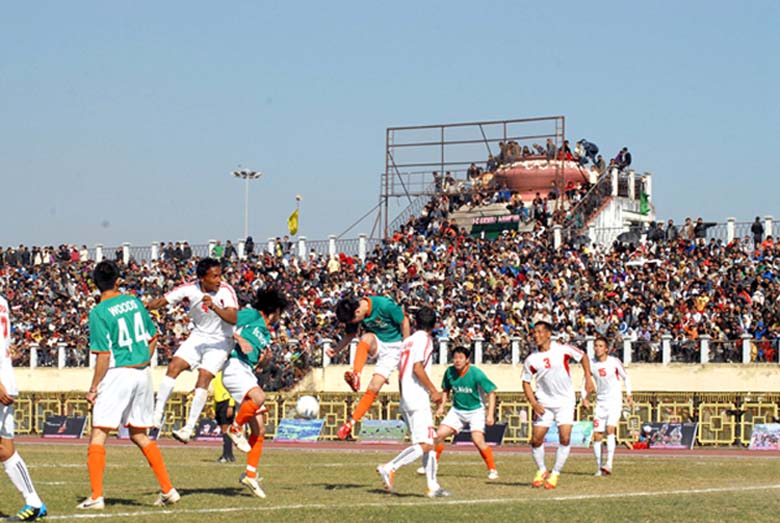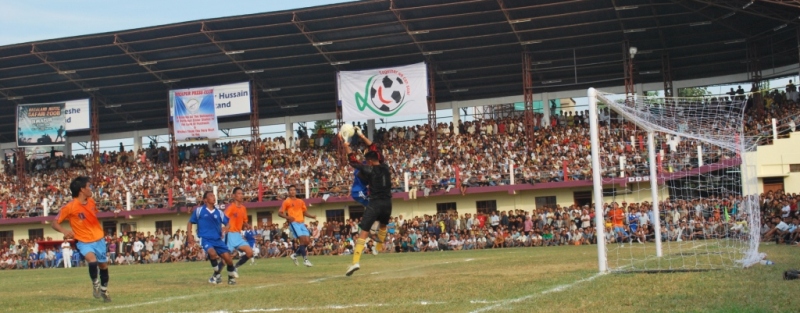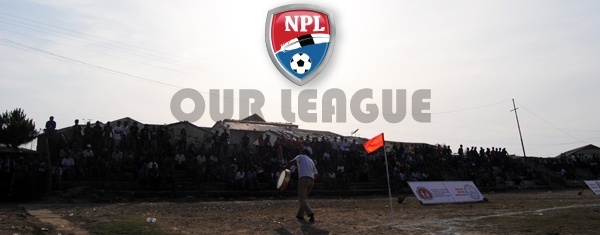With Lajong FC and United Sikkim in top division of Indian football and clubs like Royal Wahingdoh and Aizawl FC knocking at the doors, North Eastern India is the new hotbed for talents.
As United Sikkim Football Club, co-owned by the legendary Bhaichung Bhutia, qualified for next season’s I League
by winning the I League division 2 title last month, a new chapter was
written in the history of Sikkimese football. Having topped the charts
with 22 points, the Gangtok-based club ensured that the nation’s top
division clubs would get their first ever taste of football at the
scenic Paljor Stadium next season. United Sikkim’s promotion is of great
significance for the state and its budding footballers. Having produced
some of the finest footballers of the country, Sikkim has long suffered
from the exodus of talented footballers to other regions. However, with
the emergence of United Sikkim, this issue may finally be laid to rest.
Hundreds of miles away, in Shillong,
thousands of Shillong Lajong supporters would be looking forward to the
next season, full of hope, with fresh investment coming into the club in
the form of a Dubai-based MNC, Anglian Holdings. Despite a rather
forgettable season for the Indian Reds, in which they finished a lowly
tenth, Lajong would be keen to do much better in 2012-13. In stark
contrast, their local rivals Royal Wahingdoh FC would be left licking their own wounds
after having agonizingly missed out on promotion into the I League.
After dominating the early stages, the club made a suicidal gaffe in a
game against eventual I League qualifiers, ONGC, playing 4 foreigners in
the match, as against the stipulated 3. This proved costly, as
Wahingdoh, who had won the game 4-1, were penalized 3 points, which were
awarded to ONGC. They ultimately finished fourth in the final
standings.
Two other Shillong-based outfits, Ar-Hima FC and Langsning FC, failed to get past the preliminary stages. Aizawl FC,
who had turned professional this year, did extremely well to reach the
final round. The club from Mizoram’s capital city, however, came up
short in the final stages. Luangmual FC, another club from Aizawl, bowed
out in preliminary round.
Gauhati Town Club and Green Valley, the
Guwahati-based clubs, couldn’t reach the final round either. Thus, 8 out
of the 23 clubs, that took part in this season’s I League Division 2
tournament, were from the North-Eastern part of the country. However,
controversy marred the tournament, as the management of Gauhati Town
Club, one of the oldest sports institutions in the country, found its
players guilty of taking bribes from unknown sources in order to lose
games in the preliminary round at Cuttack. This scandal forced the club
authorities into disbanding its current football team, terminating the
contracts of 18 of its players. A club with the rare distinction of
being state-owned, GTC won’t be taking part in any football events for
the next three years. Despite this scandal, one must give credit to the
rest of the clubs from the North-East region for fighting shoulder to
shoulder with the other teams in the tournament.
The ‘forgotten frontier’ as it is often
termed as, the North East India has had its fair share of problems over
the years. Factors such as insurgency and natural calamities, combined
with negligence of the central government and ignorance of the country’s
mainstream media towards the region, have ensured that the development
of this region progresses at a very slow rate. The North-Eastern
society, with due course of time, found solace in sports activities
- with football, in particular, gaining popularity among the masses. As
the craze for the sport grew in the region, attendance at local football
games soared. Spectators would throng the stands to watch 22 men slug
it out on the field. To meet this rising craze, Nurul Amin, one of the
pioneers of Assamese football, initiated the ‘Independence Cup Football
Tournament’ in 1949 at Nagaon, with top clubs taking part in this yearly
event.
However, with football no longer being
confined to villages and small towns, there arose a need to initiate
such tournaments in the bigger towns and cities as well. Keeping this in
mind, the Bordoloi Trophy, named after the first Chief Minister of
Assam ‘Lokapriya’ Gopinath Bordoloi, commenced in Guwahati in 1952 at
the historic Judges Field. In a few years’ time, the Bordoloi Trophy
became the most popular tournament of the region, with major clubs from
all over the country taking part in it.
It was not merely a football tournament,
but a festival of sorts. Thousands of spectators would come to cheer on
their local clubs. Whenever either of the Calcuttan giants, namely East
Bengal or Mohun Bagan, played a game against one of the local clubs,
there would always be a special atmosphere among the crowd. Despite a
change of venue in 1961, the popularity of this tournament didn’t wither
away. In fact, rising awareness towards football in the region meant
that there would be a further rise in the crowd attendance over the next
few years.
The late 70s brought with it a rise in
the popularity of cricket in the state of Assam (along with the rest of
the country of course). Incidentally, it was around this time that the
crowds started disappearing from the stands in Bordoloi Trophy games. In
the newly formed states of Meghalaya, Manipur, Mizoram and Nagaland,
areas largely untouched by the cricket fever, the popularity of
football, however, plummeted. In Manipur, in particular, football
fanaticism reached new heights. Despite growing unrest in the state,
football blossomed in Manipur. Women didn’t shy away from the football
grounds either.
The 90s ushered in a golden era for
women’s football in Manipur, with the ladies attaining unprecedented
success at the national stage. When the India Women’s Football
Championship began in 1991, Manipur were one of the powerhouses of
women’s football in the country. Nobody, however, would have imagined
them to dominate the tournament in the coming years the way they did.
Until 2011, they went on to win 16 of these championships, missing out
on only three occasions.
The men didn’t lag behind either, with
top division clubs vying for their signatures, and some of them making
it to the national side too. Mizoram and Nagaland, on the other hand,
made giant strides during this time, making light of the lack of decent
facilities for footballers; while Sikkim presented India with Bhaichung
Bhutia.
The region’s progress in the football
field has further escalated in the third millennia, with Renedy Singh,
Surkumar Singh and Bhaichung Bhutia becoming core members of the
national side. The commencement of the Shillong Premier League in
Meghalaya’s capital city, has, over the years, gained tremendous
popularity among the locals. The thousands of fans that come over to
watch their clubs play, stand witness to this fact.
Shillong Lajong FC, the regional
powerhouses, have raised the bar for the other clubs from the region,
with their elevation into the top division of the I League. Moreover,
their dream run into the final of the 2009-10 Federation Cup has further
boosted their support throughout the region.
As things stand, the northeastern states
continue their forward progression in the football field. Manipur,
Meghalaya and Mizoram can boast of a strong following of their local
league games. In Nagaland, meanwhile, the introduction of the Nagaland
Premier League this year, has got everyone excited in the state.
Initiated by the Nagaland Football Association, this ten team event is a
new beginning in Nagaland’s football history.
Assamese football too, has come a long
way since its downfall began in the late 70s. A successful campaign in
the 2007 National games, where the team won the gold, has revived hopes
for the football aficionados in the state. Steps have been taken to
resurrect the Bordoloi Trophy, with foreign clubs being invited to take
part in the tournament in recent years.
On 13th November, the Indian national
team played its first ever game in the northeast. Playing against
Malaysia in Guwahati, the blue tigers, backed by some 20000 vociferous
fans, drew 1-1 against the South East Asian nation. With things calming
down in the region, as the central govt. holds peace talks with various
armed rebel outfits, it wouldn’t be a surprise if northeastern cities
become a regular venue for holding games involving the national side.
Northeastern football has come a long way since Nagaland-born Talimeren Ao first captained the country
post-independence. With many northeastern players becoming important
members of the blue tigers in recent years, one can only expect bigger
things from the region in the future. Perhaps, Tripura and Arunachal
Pradesh, states suffering from below par facilities, will join in the
football movement sooner than later.
Note: Pictures courtesy of www.themanipurpage.tripod.com , www.kanglaonline.com , www.dimapur.nic.in and www.nagalandpremierleague.com
-
Article written by THT Guest Author Bhargab Sarmah
Article written by THT Guest Author Bhargab Sarmah
source: http://www.thehardtackle.com/2012/indian-football-the-future-lies-in-north-eastern-india/



